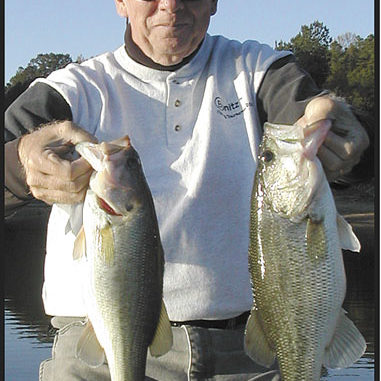
November topwater action abounds at this Raleigh-Durham reservoir.
As late summer turns to autumn, among the best spots in North Carolina to scratch the largemouth itch is Falls of the Neuse Lake.
Big fish, lots over five pounds — with quite a few larger than that — are on the move around the 14,000-acre reservoir, which is wedged between the northern edges of Durham and Raleigh.
Across the southeast, bass in reservoirs head for the backs of coves and creeks. Falls is no exception, and once they get there, fishermen can catch them with a number of different lures and techniques.
“You’ll find a real mixture of things going on, a smorgasbord,” said longtime guide Kennon Brown of Hawg Hunter Guide Service. “For one thing, there’s a great topwater bite going on.”
Brown and Tim Penhollow of Top Fishing Adventures rely on buzzbaits to do much of their November damage.
“Buzzbaits in the backs of the bays and coves can be great at Falls. In November, this is a big-fish pattern — I’m talking 8- and 9-pound fish,” Penhollow said. “This is a time when the water is cooling, and big fish group up near shallow wood and rocks.”
Brown said buzzbaits have put a lot of big fish in his boat in Novembers past.
“I rely on a Hildebrandt Headbanger,” Brown said. “I like this buzzbait because I can tune it so the rotating blade ticks the shaft. I think the extra clicking noise helps lunker bass find the lure. It’s made of tin, so you get a little different sound than with other buzzbaits.
“Since the Headbanger is made of tin and is a little lighter than other buzzbaits, it rides higher in the water column than other buzzbaits. You don’t have to work so hard to get it on the top. It’s a little smaller, but it produces the big sound.”
Brown also recommended other topwater approaches.
“In addition to the buzzbait, you might want to throw a Pop-R or some other favorite topwater,” Brown said, particularly if the largemouth are chasing small threadfin shad.
Depending on the weather, Brown suggested topwater lures might be the only strategy needed at Falls in autumn.
“If there’s cloud cover, you can fish topwaters all day productively,” Brown said. “You’ve got to let the fish tell you what to do, and if they keep hitting on the surface, keep fishing on the surface. If they quit, switch to something else.”
Bass also congregate on windy points during late autumn, according to Penhollow and Brown; the latter recommend fishing spinnerbaits around points.
“Here, largemouth want something moving. I fish the Hildebrandt spinnerbait with a gold blade and a white skirt. Gold blade – that’s the key, that’s my secret. I also like the spinnerbait with a blue glimmer. And I never throw one heavier than 3/8ths of an ounce. If the fish are deep, I slow roll it. If they are high, I wake it,” Brown said.
Penhollow recommends a somewhat different approach.
“There’s another group of bass that congregate on the corners; they’re chasing shad on rocky points,” he said. “The best spots are where wind is blowing into pockets or cuts. This is a numbers game rather than a trophy game. Throw a Rat-L Trap across the points.”
A small shallow-running crankbait is also high on the list.
“In four or five feet of water, I throw a flat-sided crankbait — sour-apple, some sort of greenish color; Tennessee shad works best,” Penhollow said. “These fish don’t want a big bait. There are some pretty big fish looking for small stuff.
“The crankbaits work best around hard cover: rocks or timber. Usually never deeper than five to eight feet.”
Both Brown and Penhollow also fish with a pig-and-jig.
“You know, I always have a jig-and-pig tied on. I use it as a search bait sometimes,” said Brown, who often uses a jig with a touch of blue in the skirt and a dark-colored plastic trailer. “It’s my favorite big-fish bait. I throw a jig-and-pig anytime I see wood.”
Penhollow goes to a jig as soon as he figures a buzzbait isn’t working.
“If they’re not hitting the buzzbait, my first alternative is the jig-and-pig,” he said, “usually some dark color – black, brown, green.”
Whether he’s fishing a buzzbait or a jig, Penhollow uses a 7-foot, medium-heavy rod and 14- to 17-pound test line.
“I expect to get a couple of big fish to bite, and I want to be able to keep them out of heavy cover,” he said. “For crankbaits, I use a 6½-foot rod with a medium action and 10- to 12-pound test line.”
Falls of Neuse is one of a handful of reservoirs in North Carolina that’s managed with special regulations aimed at retaining the lake’s quality bass. The 5-bass daily creel limit is the same as the regular statewide limit, but Falls is managed with a 16-inch size minimum.







Be the first to comment